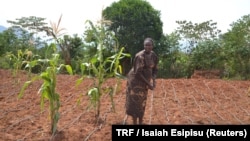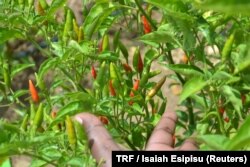At this time of year, Cherop Longiro and her husband are normally busy looking for grazing for their livestock. But their three cows died in the drought in March and they sold their 20 sheep, fearing they would meet the same fate.
"We had two options: either take them to the market and sell them at a throwaway price, or keep them, which was risky because they were most likely going to die," said Richard Longiro from his farm in Kangorio village, West Pokot County.
Over the past year herders in Kenya's Rift Valley have lost thousands of animals to worsening drought and erratic rainfall.
This is causing a growing number of them to switch to farming as a way to supplement their income.
Cherop and her husband now plant chilies - a crop resistant to drought - on a quarter-of-an-acre portion of their land, in addition to pawpaw, mangoes and bananas.
"Livestock had become so vulnerable to dry weather that we decided to start a new activity," the mother of three told the Thomson Reuters Foundation.
Resistant to Drought
Chilies are a safe bet for farmers in times of drought as they do not require fertilizers or water once the roots are established in the soil, said Giuseppe De Bac, project manager in West Pokot County for the U.N. Food and Agriculture Organization (FAO).
FAO helped negotiate a three-year agreement for 200 farmers - many of whom have lost livestock - to sell chilies to La Fattoria, an Italian company with a processing plant in the southeast of the country, at a fixed price of 200 Kenyan shillings ($1.9) per kilo. The chilies are then exported to Italy.
A quarter-of-an-acre plot of land can hold 2,500 chili plants, with each plant yielding up to 1.5 kg of chilies in three years if well tended, said De Bac.
"That could get farmers as much as 250,000 shillings ($2,409) per year, compared to only 7,500 shillings ($72) when they grew maize," he said.
Glenda Andiema, a marketing executive at La Fattoria, said the contract may be renewed at the end of the three-year period, "to involve more farmers if we see it is working well."
Herders in the region are increasingly farming crops like maize or onions in addition to keeping livestock, said De Bac.
"But most of it was only for domestic consumption - we want to help them scale up their production and derive a reliable income from it," he said.
Changing Behaviors
Although the village's farmers are starting to embrace their new crop, De Bac said the initiative has been far from straightforward.
"Farmers in this region are used to keeping livestock and if they have to grow any crops, they mainly grow maize and vegetables for domestic consumption," he said.
"Introducing them to high-value horticulture was not an easy task, even after praising the benefits of having access to a ready market."
"[Chili] needs water in the early stages of growth, so we encourage farmers to plant on drip-irrigated plots," he said.
FAO supplies the farmers with water storage tanks and drip irrigation kits, through funding from the Italian Agency for Development and Cooperation.
To date, however, some farmers prefer using sprinklers which are easier to use than the more water-efficient drip irrigation, he said.
Andiema explained that extension officers visit the village to ensure the farmers follow the correct practices, which will yield a high quality product.
La Fattoria may refuse to buy the chilies if they are of insufficient quality or quantity, she added.
Spreading the Risk
Putting farmers in touch with buyers is a good way to ensure they benefit from a ready market, while being contractually obliged to deliver produce of high quality, said Ann Mbaabu, director for market access at the Alliance for a Green Revolution in Africa, which supports smallholder farmers.
"However, the buyers must de-risk the farmers from poor yields by deploying monitoring officers on the ground to help them meet quality standards, or even linking them to insurers to provide a cushion against extreme weather," she said.
According to Haron Kibet, the county administrator in West Pokot, the fact that a community that has always relied on livestock is now pursuing an alternative source of income is a positive step.
"It will put them in a much stronger position to deal with tough climate conditions," he said.
Some of the farmers have delivered their first crop of chilies to drying centers and will receive their first payment in September once the produce has been collected.
"This is an exciting moment for us, because for the first time we are growing a crop which we know we will sell, to whom and for how much," said chili farmer Pamela Chepkorir.
($1 = 103.7500 Kenyan shillings)











